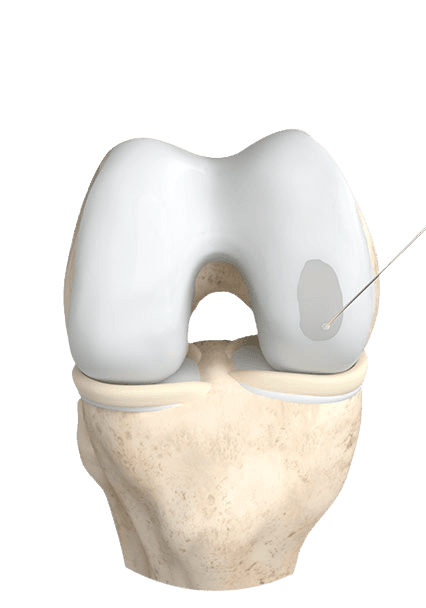About
Moderately-invasive treatment for cartilage defects, carried out under anaesthetic
Liquid cartilage injections (ChondroFiller) involve injecting a collagen-based solution directly into a damaged joint. This offers advanced cartilage repair, promoting natural healing and regeneration.

Moderately-invasive treatment for cartilage defects, carried out under anaesthetic
Not Needed
Instant-book option available
Liquid cartilage injections are a non-surgical treatment designed to restore damaged knee cartilage and relieve pain. These injections contain a synthetic or biologically derived substance designed to mimic natural cartilage, providing lubrication and cushioning in the joint. By replenishing the cartilage, liquid cartilage injections help reduce friction, improve joint movement, and slow further degeneration.
Osteoarthritis: Cartilage wear leads to pain, stiffness, and reduced mobility.
Previous knee injuries: Trauma to the knee can result in cartilage damage and joint instability.
Age-related degeneration: As we age, cartilage naturally deteriorates, causing joint discomfort.
Overuse: Repetitive activities can accelerate cartilage breakdown, leading to pain and inflammation.
Chronic inflammation: Long-term inflammation can lead to cartilage degradation and knee joint issues
Diagnosis for liquid cartilage injections starts with a clinical evaluation to assess knee pain, swelling, and reduced range of motion. Imaging tests like X-rays or MRIs help identify cartilage damage, joint space narrowing, and other knee issues.
If conservative treatments fail and cartilage damage is confirmed, liquid cartilage injections may help restore joint function and relieve pain, especially in osteoarthritis or cartilage degeneration cases.

Liquid cartilage injections (ChondroFiller) aim to replace parts of the joint that have been damaged due to injury or arthritis. This treatment can be done through an injection or, in some cases, surgery (such as arthroscopy), depending on the severity of the damage.
The process involves gaining access to the affected joint by arthroscopy (keyhole surgery). Once the defect is found, the collagen matrix is introduced. This matrix acts like scaffolding, stimulating and providing support for the new, healthy cartilage to grow around.
Liquid cartilage injections are a great solution for those with ongoing knee or ankle pain, who are looking for a low-risk, fast healing time procedure.

Minimally-invasive, can be performed via keyhole surgery
Ideal for small and difficult-to-reach injures/defects
Faster recovery time (compared to surgical treatments)
Helps restore the joint’s normal function
We offer a range of flexible payment options to make your treatment experience smooth and stress-free.
Most patients choose to self-fund their treatment. We accept:
We’ve partnered with GoCardless to offer interest-free instalment options. You can easily set up a Direct Debit to spread the cost of your treatment over time.
Looking for a financing plan? You can apply through Kandoo, our trusted finance partner.
We work with a small number of approved insurance providers. However, due to restrictions from many insurers, not all treatments are covered. Please check with your insurer and speak to our team before booking to avoid disappointment.
Use our website to book an initial consultation, or give us a call.
Our doctors might request you arrange a scan before your initial consultation. Or, they’ll chat with you (face to face or online) and recommend a scan after your initial consultation, if they think you need one.
Once your scan results have been reviewed, and your doctor has explained your options, you will be booked in for treatment.
Following your treatment, your doctor will give you rehab recommendations.
You will be booked in for a follow-up consultation, so your doctor can check your progress. You might need further rehab after this consultation.
Once your doctor is happy with your recovery, you will be discharged. After discharge, we are always here for further questions or support, should you need it.
How long until I notice results?
You should notice improvements in as few as 4-6 weeks, with benefits lasting as long as 6-12 months in most cases.
Several factors will impact the effectiveness and overall timeline, including how badly the cartilage is damaged, your general health and age, as well as your diet, lifestyle and adherence to aftercare following your treatment.
Are there any side effects?
Who is suitable for Liquid Cartilage Injections?
What are Liquid Cartilage Injections and how do they work?
Are there any payment or finance options available for this treatment?

Hyaluronic acid injections offer an effective, minimally invasive treatment for joint pain, particularly in osteoarthritis. This therapy works by restoring joint lubrication, reducing pain, and improving mobility. Patients may experience mild discomfort sho...

Discover essential aftercare tips for hyaluronic acid injections to ensure optimal results and minimize side effects. Learn what foods and activities to avoid in the first 48 hours, how to manage swelling and bruising, and when to seek medical advice. Exper...

Hyaluronic acid injections are a popular non-surgical treatment for joint pain caused by osteoarthritis, providing relief by restoring joint cushioning. Typically, pain relief lasts four to six months, varying by joint and individual factors such as arthrit...
Explore the key differences between leading injection therapies used in joint, tendon, and cartilage care. Compare their effectiveness, uses, recovery time, and potential drawbacks to help guide your treatment decisions.
Injection Type
Best For
Effectiveness
What It Does
Recovery Time
Downside
Hyaluronic Acid (HA) Injection
Cartilage Matrix Injection
Arthrosamid Injection (Hydrogel)
PRP (Platelet-Rich Plasma) Injection
mFAT (Microfragmented Adipose Tissue) Injection
BMAC (Bone Marrow Aspirate Concentrate) Injection
Cortisone (Steroid) Injection
Exosome Injection
Best For
Moderate to severe cartilage damage, osteoarthritis, surgical augmentation
Effectiveness
What It Does
Provides a structural scaffold to support cartilage repair and regeneration.
Recovery Time
Minimal downtime, improvement in 4-6 weeks, lasting 6-12 months.
Downside
May lead to mild inflammation or require combination with other therapies for best results.
Best For
Mild to moderate knee osteoarthritis, joint lubrication
Effectiveness
What It Does
Lubricates joints, reduces friction, and relieves pain in osteoarthritis.
Recovery Time
Immediate return to daily activities, effects last 3-12 months.
Downside
Short-term relief, effects wear off over time; does not regenerate cartilage.
Don’t wait to find relief. Whether it’s a consultation, scan, or treatment, we’re ready to help. Book a call with the admin team to discuss.